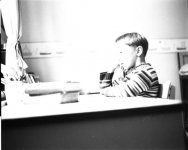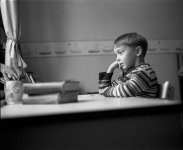soubresaut17
Newbie
I wonder if anyone has encountered this problem with Nikon Coolscan 9000. The problem happens when using rotating glass holder and results in overexposed and extremely high contrast scans. It tends to happen when a large part of a negative is much darker than the remaining part.
I remember several times before when getting that kind of scans I thought that the problem is a poor quality of a negative. But today the negative was so obviously good that I decided to try and scan it with my long unused “kit” holder. It yielded an excellent (in terms of exposure and contrast) image. But of course the “kit” holder doesn’t scan sharply the whole area of a negative.
I attach both files here. So it seems that Coolscan 9000 refuses to make quality scans: The simple glassless holder results in not very sharp images, and an expensive glass holder sometimes (I admit that it happens rarely) give rise to extreme contrast and overexpose. I can adjust exposure but it seems that it is impossible to adjust contrast. Can anyone suggest how this could be resolved??? Thank you!
I remember several times before when getting that kind of scans I thought that the problem is a poor quality of a negative. But today the negative was so obviously good that I decided to try and scan it with my long unused “kit” holder. It yielded an excellent (in terms of exposure and contrast) image. But of course the “kit” holder doesn’t scan sharply the whole area of a negative.
I attach both files here. So it seems that Coolscan 9000 refuses to make quality scans: The simple glassless holder results in not very sharp images, and an expensive glass holder sometimes (I admit that it happens rarely) give rise to extreme contrast and overexpose. I can adjust exposure but it seems that it is impossible to adjust contrast. Can anyone suggest how this could be resolved??? Thank you!
Attachments
benjaminspell
Newbie
Are you scanning in Nikon Scan 4? What settings are you using. I use this scanner both with and without the glass holder and have had great results. I never let the scanner decide on exposure or anything and only use manual controls. Maybe this is the problem?
filmfan
Well-known
I don't know how much different the 8000 is from the 9000, but with my 8000 I have NEVER adjusted anything manually. I always let the scanner do its thing in auto and it always works out fine-- with and without glass holders.
soubresaut17
Newbie
Yes, I use Nikon Scan 4. I never turn on Scan Image Enhancer. Digital ICE is off also. Digital ROC, GEM and DEE are off. Bit depth is 16, Multisample is 1. I tried to adjust analog gain but it doen't help because of huge contrast. Using glassless holder with the same settings results in good quality scan 
mfogiel
Veteran
I think the reason is probably quite simple. You have to make sure, that the selected area for scannong has no film border or empty spaces in it. You should always display the histogram in preview, and if you adjust the image area, redo the preview before scanning, or manually adjust the white and black points. This way the scanner can optimally adjust for average density of the image, and you extract the maximum tonal information from your negative. I recommend useing Vuescan for best results.
dcsang
Canadian & Not A Dentist
I think the reason is probably quite simple. You have to make sure, that the selected area for scannong has no film border or empty spaces in it. You should always display the histogram in preview, and if you adjust the image area, redo the preview before scanning, or manually adjust the white and black points. This way the scanner can optimally adjust for average density of the image, and you extract the maximum tonal information from your negative. I recommend useing Vuescan for best results.
I would concur save for the using Vuescan - I've got both (Nikon Scan 4 and VueScan) and I just like what I get out of Nikon Scan better. That said, I'm not using the rotating glass - but I am using just some Ebay ANR glass in the 120 holder - I have no issues with my scans using that method.
Cheers,
Dave
hlockwood
Well-known
I think the reason is probably quite simple. You have to make sure, that the selected area for scannong has no film border or empty spaces in it. You should always display the histogram in preview, and if you adjust the image area, redo the preview before scanning, or manually adjust the white and black points. This way the scanner can optimally adjust for average density of the image, and you extract the maximum tonal information from your negative. I recommend useing Vuescan for best results.
I agree that adjusting the scanned area in Preview is important. But it is my understanding from others here and from a consult with Nikon directly that any tonal adjustments to the histogram will be applied only after the scan. This means, for me, that these adjustments are best done in PS or other editor where there is likely to be a greater degree of control.
If anyone has done any definitive testing on this issue, we would all like to hear about it.
Harry
Edit: I should have added that my question to the Nikon technician was related to NikonScan and the 4000ED, but I suspect that the answer applies to all Nikon scanners.
Last edited:
soubresaut17
Newbie
Thanks all for your suggestions. I tried to scan with Vuescan and the problem disappeared. So it was Nikon Scan to blame.
Chriscrawfordphoto
Real Men Shoot Film.
What size film is it? The 35mm masks included with the glass rotating carrier (the carrier I use for everything) are too big for a normal 35mm frame. They're made for panoramic frames from an Xpan or Widelux type camera. If you scan a 35mm frame that is next to a blank frame, like at the end of a roll of next to one you shot with the lenscap on, the large clear area shown by the mask fools the scanner into giving the wrong exposure.
soubresaut17
Newbie
Christopher, thank you for reply. It is medium format film 6x7. No blank areas at all. It seems that the problem is in software as it doesn't manifest itself when using Vuescan instead of Nikon scan.
Timmyjoe
Veteran
I used to have a similar issue with the earlier Nikon Coolscan III. It would be working fine and then, bam, super high contrast. Talked to the Nikon Tech folks and they said it was an issue with the software, (and since I use a Mac) the solution was to close Nikon Scan, throw the Nikon Scan preferences into the trash, empty the trash, then relaunch Nikon Scan. And the problem went away.
i've got a Coolscan 9000 now (which I love for scanning B&W) and each time I turn on the scanner, before I launch Nikon Scan, I trash the preferences. Even still, sometimes after hours of scanning the contrast will go a little wonky, so I close Nikon Scan, trash the preferences again, and relaunch, and everything is fine.
Found this works with all the different negative holders I have, including the non-rotating Newton glass carrier.
Hope that helps.
Best,
-Tim
i've got a Coolscan 9000 now (which I love for scanning B&W) and each time I turn on the scanner, before I launch Nikon Scan, I trash the preferences. Even still, sometimes after hours of scanning the contrast will go a little wonky, so I close Nikon Scan, trash the preferences again, and relaunch, and everything is fine.
Found this works with all the different negative holders I have, including the non-rotating Newton glass carrier.
Hope that helps.
Best,
-Tim
Last edited:
Share:
-
This site uses cookies to help personalise content, tailor your experience and to keep you logged in if you register.
By continuing to use this site, you are consenting to our use of cookies.


